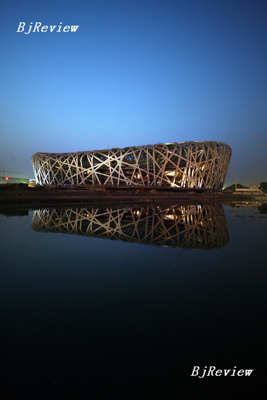
In about one year from now, on the night of August 8, 2008, the Olympic flame of the 2008 Olympic Games will be lit at the opening ceremony in China's National Stadium, now under construction, which is the main track and field stadium for the competition.
The landmark stadium in the northern part of Beijing earned the nickname Bird's Nest because of its structural elements that mutually support each other and converge into a grid-like formation--almost like a bird's nest with its interwoven twigs. The appearance of this stadium is one of synergy, with no distinction made between the facade and the superstructure. The spatial effect of the stadium is novel and radical, yet simple and of an almost archaic immediacy.
The arrangement of the bowl structural grid has been chosen to allow a significant amount of repetition in the design and construction of the stadium, and the column spacing is generally less than nine meters, except in the single bay where the grid transitions from elliptical to circular.
The bowl-like performing area has adopted the color of deep earthy red, the color of the walls and palaces of Forbidden City, which grants the architecture a unique eastern beauty. The stadium, with a floor area totaling 250,000 square meters, will also host the closing ceremony and some much anticipated games, like the men's soccer matches and the track and field events.
In April 2002 Beijing engaged architects worldwide in a design competition. Pritzker Prize-winning Swiss architects Jacques Herzog and Pierre de Meuron collaborated with China Architecture Design & Research Group to win the competition.
The ground was broken in December 2003, and construction started in March 2004, but was halted by high construction costs and safety concerns in August 2004. In the new design, while the major features and the style of the design have been maintained, the roof of the stadium has been omitted. Experts say that this will make the stadium safer, while reducing construction costs. The construction of the Olympic buildings continued once again in December 2004.
The concrete work of the main stand was completed on November 15, 2005, one month ahead of schedule. On August 31, 2006, the steel skeleton was welded together. On September 17 of the same year, the steel structure of the national stadium stood on its own when the last piece of the supporting structures was removed.
Beijing's hosting of the Olympic Games has provided a test land for architects and art designers. Of all the futuristic buildings, the Bird's Nest has created the most testing opportunities for new construction technologies and is regarded by architects as a dream work of blending structure with function.
With the domestic controversies surrounding the concept of the building and cost of construction, it has been likened by some Western architects to the Eiffel Tower, which started as a "blight" on Paris and winded up becoming one of the most recognized structures in the world.
"The shape of the National Stadium is striking at first sight, but further observation can discover coziness and peacefulness in this shape," said Mei Jikui, architecture professor of Harbin Institute of Technology and a member of the judging panel in the bid to build the National Stadium. Many architecture experts agree that the Bird's Nest design deeply symbolizes the quest for peace and a harmonious world.
The design of the Bird's Nest reflects the long-time style of Herzog and de Meuron of combining their works with nature. One outstanding feature of the stadium is that people seated on all of its seven floors will be around 140 meters away from the exact center of the field, allowing for equal views for all the audience. The audience area also hosts over 200 armchair seats for physically challenged people, which are higher than ordinary seats to provide an easier view.
Since the stadium is designed for an audience of more than 90,000 to watch sport games simultaneously, the designers have incorporated noise absorbing materials into its construction. The use of high-end loudspeakers and amplifiers guarantee that audiences in every corner of the stadium will be able to hear broadcasts clearly.
The stadium is the first of its kind in China to use solar power as a power complement. As the last Olympic venue to be completed, the stadium will not be handed over until the end of March next year. But the final unveiling should prove worth the wait. | 